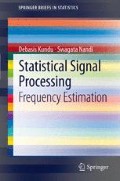Abstract
In the previous two chapters, we have discussed different estimation procedures of model (3.1) and properties of these estimators. In all these developments, it has been assumed that the number of components ‘p’ is known in advance. But in practice estimation of p is also a very important problem. Although, during the last 35 to 40 years extensive work has been done in estimating the frequencies of model (3.1), not that much of attention has been paid in estimating the number of components p.
Access this chapter
Tax calculation will be finalised at checkout
Purchases are for personal use only
References
Fisher, R. A. (1929). Tests of significance in harmonic Analysis. Proceedings of the Royal Society London Series A, 125, 54–59.
Quinn, B.G. (1986). Testing for the presence of sinusoidal components. Journal of Applied Probability, 23(A), 201–210.
Quinn, B. G., & Hannan, E. J. (2001). The estimation and tracking of frequency. New York: Cambridge University Press.
Rao, C. R. (1988). Some results in signal detection. In S. S. Gupta & J. O. Berger (Eds.), Decision theory and related topics IV (pp. 319–332). New York: Springer.
Kundu, D., & Kundu, R. (1995). Consistent estimates of super imposed exponential signals when observations are missing. Journal of Statistical Planning and Inference, 44, 205–218.
Kundu, D., & Mitra, A. (1995). Consistent method of estimating the superimposed exponential signals. Scandinavian Journal of Statistics, 22, 73–82.
Akaike, H. (1969). Fitting autoregressive models for prediction. Annals of the Institute of Statistical Mathematics, 21, 243–247.
Akaike, H. (1970). Statistical predictor identification. Annals of the Institute of Statistical Mathematics, 22, 203–217.
Schwartz, S. C. (1978). Estimating the dimension of a model. Annals of Statistics, 6, 461–464.
Rissanen, J. (1978). Modeling by shortest data description. Automatica, 14, 465–471.
Bai, Z. D., Krishnaiah, P. R., & Zhao, L. C. (1986). On the detection of the number of signals in the presence of white noise. Journal of Multivariate Analysis, 20, 1–25.
Kundu, D. (1992). Detecting the number of signals for undamped exponential models using information theoretic criteria. Journal of Statistical Computation and Simulation, 44, 117–131.
Sakai, H. (1990). An application of a BIC-type method to harmonic analysis and a new criterion for order determination of an error process. IEEE Transaction of Acoustics Speech Signal Process, 38, 999–1004.
Quinn, B. G. (1989). Estimating the number of terms in a sinusoidal regression. Journal of Time Series Analysis, 10, 71–75.
An, H.-Z., Chen, Z.-G., & Hannan, E. J. (1983). The maximum of the periodogram. Journal of Multivariate Analysis, 13, 383–400.
Wang, X. (1993). An AIC type estimator for the number of cosinusoids. Journal of Time Series Analysis, 14, 433–440.
Kavalieris, L., & Hannan, E. J. (1994). Determining the number of terms in a trigonometric regression. Journal of Time Series Analysis, 15, 613–625.
Kundu, D. (1997). Estimating the number of sinusoids in additive white noise. Signal Processing, 56, 103–110.
Kundu, D. (1998). Estimating the number of sinusoids and its performance analysis. Journal of Statistical Computation and Simulation, 60, 347–362.
Author information
Authors and Affiliations
Rights and permissions
Copyright information
© 2012 The Author(s)
About this chapter
Cite this chapter
Kundu, D., Nandi, S. (2012). Estimating the Number of Components. In: Statistical Signal Processing. SpringerBriefs in Statistics. Springer, India. https://doi.org/10.1007/978-81-322-0628-6_5
Download citation
DOI: https://doi.org/10.1007/978-81-322-0628-6_5
Published:
Publisher Name: Springer, India
Print ISBN: 978-81-322-0627-9
Online ISBN: 978-81-322-0628-6
eBook Packages: Mathematics and StatisticsMathematics and Statistics (R0)

